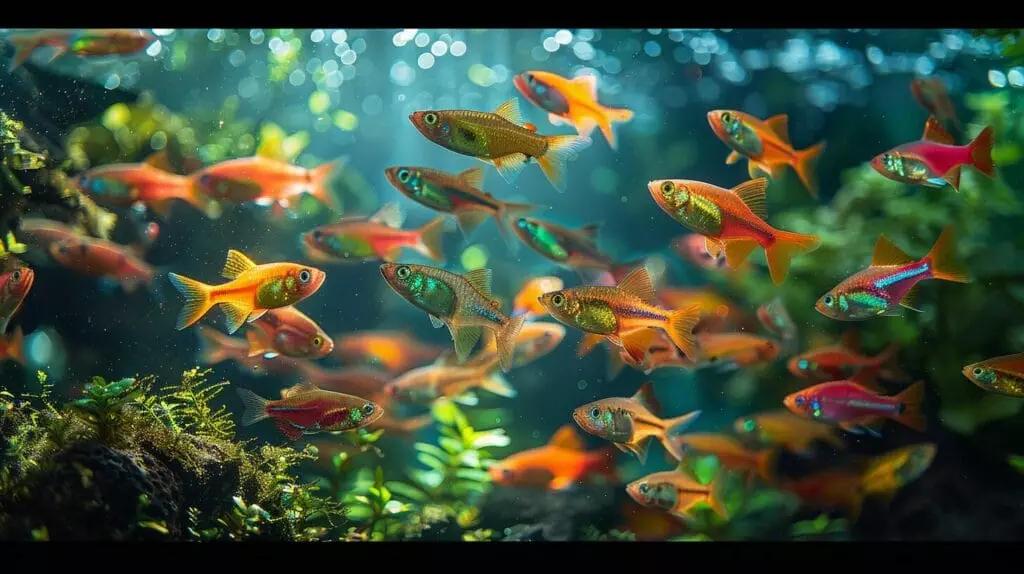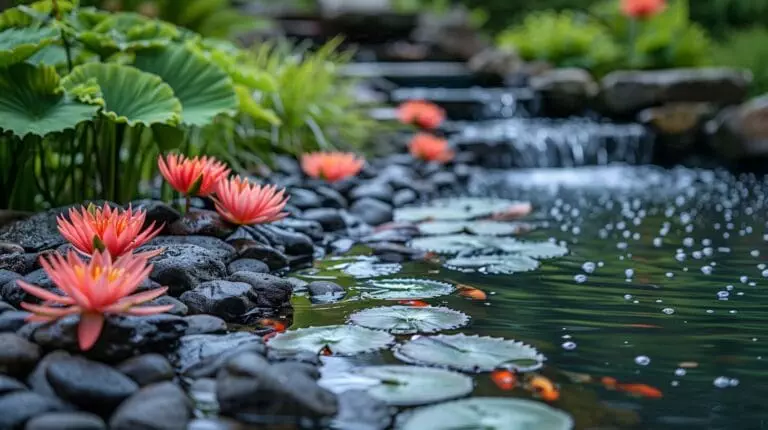Start your journey into aquarium keeping with tropical community fishes! Discover the basics of setting up a vibrant underwater world. Learn about beginner-friendly tropical fish species, compatible tank mates, and essential tips for maintaining water quality.
In our Tropical Community Fishes guide, we will dive into the exciting world of aquariums and create your aquatic paradise.
Key Takeaways
- Select peaceful and easy-to-care-for species for beginner-friendly setups.
- Include small, visually appealing fish like Guppies and Neon Tetras.
- Mimic natural habitats with live plants and suitable water parameters.
- Ensure compatibility in size and temperament for harmonious coexistence.
- Monitor breeding behaviors and provide appropriate conditions for successful reproduction.
Understanding Community Aquariums and Tropical Fish Compatibility

Understanding the compatibility of various tropical fish species is crucial for establishing a harmonious tank environment. Peaceful fish that coexist amicably should be selected for community tanks.
Different species have unique temperaments, making it important to choose those that maintain balance within the aquarium. Species like Corydoras catfish, which dwell at the bottom and clean food scraps and debris, contribute to tank cleanliness. Including schooling fish such as neon tetras or rasboras adds vibrancy and movement to the tank, providing security for the fish within the group, creating an enchanting display of neon blue hues.
Selecting the Right Mix of Tropical Fish for a Balanced Aquarium

Creating a balanced aquarium involves considering factors such as size, temperament, and compatibility among fish species. Smaller, peaceful fish are generally more suitable for community setups, ensuring harmonious coexistence among tank mates. Choosing easy-to-care-for species simplifies maintenance for beginner aquarists. Here is a guide for selecting the right mix of tropical fish for your aquarium:
| Type of Fish | Description |
|---|---|
| Guppy | Small, colorful, and easy to breed |
| Neon Tetra | Peaceful, shoaling fish that add vibrancy to the tank |
| Cory Catfish | Bottom-dwellers that help keep the tank clean |
| Platies | Hardy fish available in various colors |
| Mollies | Sociable fish that thrive in community setups |
Community Aquarium

Creating an ideal environment for tropical community fish involves considering the specific habitat needs of the different species in the tank. Fish thrive in freshwater aquariums that replicate their natural habitats. Introducing live plants not only adds beauty but also provides hiding spots for fish to feel secure.
Ensure the water temperature and pH levels are suitable for the species in the tank. Different fish have unique care requirements. For example, Corydoras prefer sandy substrates at the bottom of the tank, while Swordtails appreciate densely planted areas.
Feeding and Caring for a Diverse Tropical Community Fish

Feeding and caring routines for tropical community fish should take into account the specific needs of each species. Guppies, tetras, and gouramis, which are popular choices, generally thrive on a diet of high-quality flake or pellet food supplemented with occasional treats like live or frozen foods. Including plecos, known for their alga control, can be beneficial. A varied diet will help keep these fish healthy and vibrant.
In addition to feeding, proper care is vital for the well-being of your tropical fish. Regular water changes, monitoring water parameters, and keeping the tank clean are essential maintenance tasks. Be vigilant for common fish diseases such as Ich and fin rot, and promptly treat any issues that arise.
Some tropical community fish, like the sensitive pearl gourami and harlequin rasbora, may require extra attention. Providing them with a well-established tank, suitable tank mates, and a calm environment can help these species thrive.
Breeding Tropical Fish in a Community Aquarium

Breeding tropical fish in a community aquarium requires careful observation of mating behaviors and providing appropriate breeding conditions for different species. When it comes to breeding tropical fish like neon tetras and guppies, creating a vital environment is important.
Neon tetras prefer dimly lit tanks with plants for spawning, while guppies thrive in densely planted tanks with hiding spots for fry. Maintaining stable water conditions, such as appropriate temperature and pH levels, is essential for successful breeding in a community aquarium, especially when aiming for a harmonious mix of sizes, including both small size and larger species.
For neon tetras, mimicking their natural habitat with soft, acidic water can encourage spawning behavior. On the other hand, guppies are prolific breeders that require ample space for fry to grow safely away from adult fish. By closely monitoring the breeding pairs and adjusting the tank setup accordingly, hobbyists can increase the chances of successful breeding in their community aquarium.
Conclusion
Overall, creating a tropical community aquarium is a rewarding and enjoyable experience. By selecting compatible fish species, creating a balanced environment, and providing proper care and nutrition, your aquarium can thrive with a diverse array of colorful and fascinating tropical fish.
Whether you’re a beginner or a seasoned hobbyist, the beauty and tranquility of a tropical community aquarium, home to some of the best community fish, is sure to bring joy and relaxation to your home. With a wide variety of colorful and peaceful species to choose from, such as guppies, tetras, and mollies, a tropical community aquarium offers a vibrant and captivating display for all to enjoy. Enhance the natural and serene ambiance of your aquarium by adding freshwater aquarium plants, which not only provide a natural habitat for your fish but also contribute to the overall health of the tank. Plus, with proper care and maintenance, a tropical community aquarium can be an enjoyable and rewarding pastime for aquarium enthusiasts of all levels.
Frequently Asked Questions
What are some common tropical community fishes for beginners?
Some common tropical community fishes for beginners include neon tetra, guppy, pearl gourami, cherry barb, and cory catfish.
How do I set up an aquarium for tropical community fishes?
To set up an aquarium for tropical community fishes, you will need a fish tank, suitable filtration system, heater, substrate, plants, and decorations.
What are some popular species of gourami for a beginner’s aquarium?
Popular gourami species for a beginner’s aquarium include pearl gourami, dwarf gourami, and honey gourami.
How should I introduce new fish to a community tank?
When introducing new fish to a community tank, it’s advisable to quarantine them first to prevent the spread of diseases and aggression amongst fish. Acclimate them slowly to the tank water temperature before releasing them to minimize stress and aggression.
What are some tips for maintaining a healthy freshwater community tank?
To maintain a healthy freshwater community tank, ensure regular water changes, monitor water parameters, provide a balanced diet, and avoid overstocking the tank.




